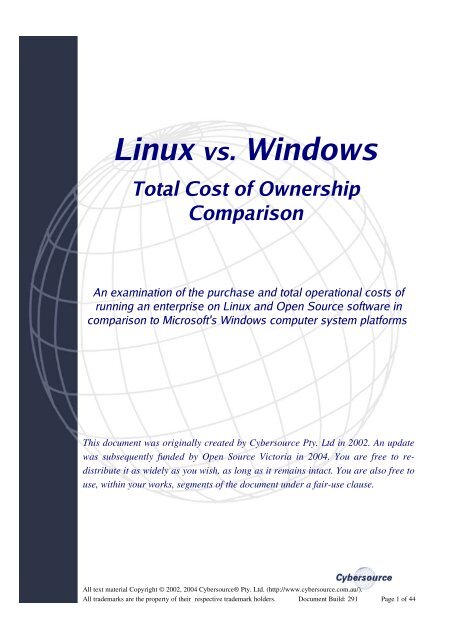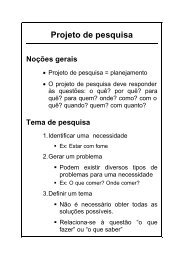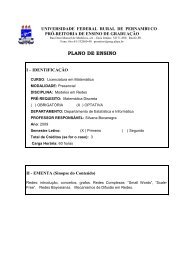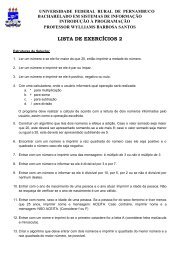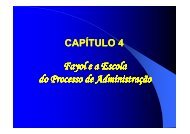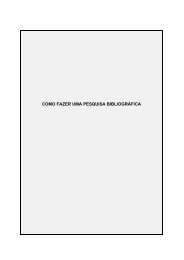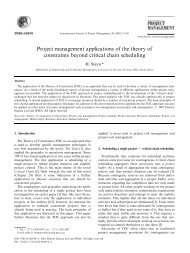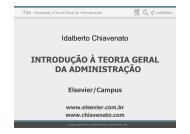Linux vs. Microsoft TCO Comparison
Linux vs. Microsoft TCO Comparison
Linux vs. Microsoft TCO Comparison
Create successful ePaper yourself
Turn your PDF publications into a flip-book with our unique Google optimized e-Paper software.
<strong>Linux</strong> <strong>vs</strong>. WindowsTotal Cost of Ownership<strong>Comparison</strong>An examination of the purchase and total operational costs ofrunning an enterprise on <strong>Linux</strong> and Open Source software incomparison to <strong>Microsoft</strong>'s Windows computer system platformsThis document was originally created by Cybersource Pty. Ltd in 2002. An updatewas subsequently funded by Open Source Victoria in 2004. You are free to redistributeit as widely as you wish, as long as it remains intact. You are also free touse, within your works, segments of the document under a fair-use clause.All text material Copyright © 2002, 2004 Cybersource® Pty. Ltd. (http://www.cybersource.com.au/).All trademarks are the property of their respective trademark holders. Document Build: 291 Page 1 of 44
DisclaimerThe information contained herein represents Cybersource's initial commentary andanalysis and has been obtained from sources believed to be reliable. Positions taken aresubject to change as more information becomes available and further analysis isundertaken. Cybersource and Open Source Victoria disclaim all warranties as to theaccuracy, completeness or adequacy of the information. Neither Cybersource nor OpenSource Victoria shall have liability for errors, omissions or inadequacies in the informationcontained herein or for interpretations thereof.It is recommended that enterprises considering a migration to, or implementation of, anOpen Source solution undertake their own Total Cost of Ownership and Return OnInvestment evaluations, specific to their requirements, prior to any such implementation.This document can therefore be considered a first-pass template for such a site-specificevaluation.AcknowledgementsCybersource gratefully acknowledges the support of Open Source Victoria in preparingthis updated version of the <strong>Linux</strong> <strong>vs</strong>. Windows <strong>TCO</strong> <strong>Comparison</strong> document.Open Source Victoria is an industry cluster, funded by the State Government of Victoria,Australia. Open Source Victoria consists of over 80 Victorian firms and developers whichprovide services and technology related to Free and Open Source Software (FOSS.) OpenSource Victoria offers marketing, advocacy and information referral services, and aims toraise the profile of FOSS in Victoria and work with other similar organisations acrossAustralia. For more information visit: http:// www.osv.org.au /All text material Copyright © 2002, 2004 Cybersource® Pty. Ltd. (http://www.cybersource.com.au/).All trademarks are the property of their respective trademark holders. Document Build: 291 Page 2 of 44
Table of ContentsDisclaimer...................................................................................................2Acknowledgements.......................................................................................2Executive Summary....................................................................................4<strong>TCO</strong>: Summary of Results............................................................................5Introduction.................................................................................................7A Note on Methodology..............................................................................9Alternative Studies....................................................................................10A Look at Migration Costs.........................................................................13Total Cost of Ownership...........................................................................15Hardware, Platforms...................................................................................15Applications, Salaries..................................................................................17Service Charges.........................................................................................19Windows Platform Solution.........................................................................21<strong>Linux</strong> Platform Standard Solution...............................................................23<strong>Linux</strong> Platform Enterprise Solution.............................................................24Scenario 1: All New Hardware....................................................................26Scenario 2: Pre-Existing Hardware.............................................................28Software Licence Costs............................................................................29Hardware Specification and Costs..............................................................32Salaries and Services Costs.......................................................................35Appendix 1................................................................................................37Pricing Research Method............................................................................37Appendix 2................................................................................................39Software Pricing Resources........................................................................39Appendix 3................................................................................................41Hardware and Services Pricing...................................................................41Appendix 4................................................................................................42Information and References for <strong>Linux</strong> ........................................................42About Cybersource...................................................................................44All text material Copyright © 2002, 2004 Cybersource® Pty. Ltd. (http://www.cybersource.com.au/).All trademarks are the property of their respective trademark holders. Document Build: 291 Page 3 of 44
Executive SummaryThere has been significant interest in the broader business community regarding thedifference in the Total Cost of Ownership (<strong>TCO</strong>) between the <strong>Linux</strong> and Open Sourcesolutions on one side and <strong>Microsoft</strong>'s proprietary Windows solutions on the other.<strong>Microsoft</strong> software is licenced to users on a fee-for-product basis, whereas most <strong>Linux</strong> andopen source applications are available free of charge. There are, however, installation andsupport costs to consider. We will take all such costs into consideration in the models wepresent.While it is difficult to qualitatively analyse all of the <strong>TCO</strong> factors at play, it is possible toproduce a reasonable first-pass quantitative estimate for the instantiation and operation ofa complete computer environment and network infrastructure for a small-to-mediumorganisation, to illuminate the <strong>TCO</strong> differences between these two competing platforms.To that end, we have modelled an organisation with 250 computer-using staff, anappropriate number of workstations, servers, Internet connectivity, an e-business system,network cabling and hardware, standard software, and salaries for IT professionals toestablish and support this infrastructure and technology. We've also added IT training forthe staff along with expenditure items for ancillary IT systems and external consultingstaff to assist in making it all work.We ran the model with two options: firstly, purchasing brand new hardware and networkinfrastructure explicitly for establishing this organisation's computer systems; andsecondly, using pre-existing hardware and infrastructure. We also simulated the ITexpenses over a 3 year period, mimicking the operational life-span of many corporatecomputer systems, and amortising the purchase and installation costs over that period oftime.Throughout this comparison, we will be presenting the raw data as well as the explicativemethodologies used in the determination of the overall costs. While we have taken careand effort to present a holistic analysis, we are mindful that no organisation is likely tooperate with the exact parameters presented here, and we therefore recommend the use ofthe document as a guide only. Consider this document as a primer which you can use togenerate an enhanced <strong>TCO</strong> model specifically tailored for your organisation, by removingthose line items which don't make sense for your site and adding additional costs whichare specific to your organisation.Further, while this document makes express use of technology and services found withinthe IT industry, it is intended for an audience of non-IT executives within small to mediumsized organisations.What's NewWe've expanded and improved this version of the <strong>TCO</strong> document in many ways, to reflectAll text material Copyright © 2002, 2004 Cybersource® Pty. Ltd. (http://www.cybersource.com.au/).All trademarks are the property of their respective trademark holders. Document Build: 291 Page 4 of 44
oth the altered state of the IT industry and to enhance the validity and reality of themodel. We add <strong>Microsoft</strong>'s Software Assurance, which didn't exist three years ago, we'veincreased the level of expenses for external support and we've included training expensesfor the first time.Additionally, since various industry players have begun to claim that <strong>Linux</strong> is no longerfree of cost because some enterprise <strong>Linux</strong> suppliers have enacted mandatory supportcontract agreements, we have also added one of these suppliers into our comparison.Therefore, from this version on, we compare and contrast standard <strong>Linux</strong>, Red HatEnterprise <strong>Linux</strong> and <strong>Microsoft</strong> platforms.We've also expanded the number of ancillary expenses, including such items as printersetc., to better reflect business realities.<strong>TCO</strong>: Summary of ResultsThe final results are summarized in the tables below. One compares the <strong>TCO</strong> differencebetween Standard <strong>Linux</strong> (namely the one that isn't acquired with a pre-paid supportcontract) and <strong>Microsoft</strong>'s platform. The second compares Red Hat's managed Enterprise<strong>Linux</strong> and <strong>Microsoft</strong>'s platform. Both models include costings for deployment on either asite's existing equipment or through a complete hardware refresh.Standard <strong>Linux</strong> Solution <strong>vs</strong>. <strong>Microsoft</strong> Solution<strong>Microsoft</strong><strong>Linux</strong>SavingsPercentageSolutionStandardAchieved bySavedSolutionUsing OpenSourceExisting hardware& infrastructure isused $1,066,712 $682,090 $384,622 36%New hardware &infrastructure ispurchased $1,366,883 $1,012,260 $345,623 26%All text material Copyright © 2002, 2004 Cybersource® Pty. Ltd. (http://www.cybersource.com.au/).All trademarks are the property of their respective trademark holders. Document Build: 291 Page 5 of 44
Red Hat Enterprise <strong>Linux</strong> Solution <strong>vs</strong> <strong>Microsoft</strong> Solution<strong>Microsoft</strong>Red HatSavingsPercentageSolutionEnterpriseAchieved bySaved<strong>Linux</strong>Using OpenSolutionSourceExisting hardware& infrastructure isused $1,066,712 $781,279 $285,433 27%New hardware &infrastructure ispurchased $1,366,883 $1,111,450 $255,433 19%<strong>Linux</strong> <strong>vs</strong> Windows <strong>TCO</strong> <strong>Comparison</strong>$1,400,000.00$1,300,000.00$1,200,000.00$1,100,000.00$1,000,000.00$900,000.00$800,000.00$700,000.00$600,000.00$500,000.00$400,000.00$300,000.00$200,000.00Standard <strong>Linux</strong>Red HatEnterprise <strong>Linux</strong><strong>Microsoft</strong>$0.00Using Existing HardwareUsing New HardwareThroughout this document all prices are in US$ for ease of conversionto your currency, and correct as of 2004-09-16.All text material Copyright © 2002, 2004 Cybersource® Pty. Ltd. (http://www.cybersource.com.au/).All trademarks are the property of their respective trademark holders. Document Build: 291 Page 6 of 44
IntroductionIn early 2002, Cybersource undertook a study into the differences in total cost ofownership between <strong>Linux</strong> and Open Source software on the one hand, and <strong>Microsoft</strong>'soperating systems and applications on the other. Total cost of ownership is a measure ofthe total costs which each technology platform will incur for an organisation deployingthat platform.In late 2004, Open Source Victoria (OSV), an industry cluster promoting open standardsand open source in business, government and education, requested an updated andimproved version of that initial document. This is part of a documentation set that OSV ispreparing to assist organisations considering the adoption of <strong>Linux</strong> and open sourcesolutions.This <strong>TCO</strong> comparison will be available online from now on at:http:// www.cybersource.com.au /about/linux _<strong>vs</strong>_windows_ tco _ comparison.pdfThis report is segmented into a number of sections Firstly, we cover the reasoning andmethodology of the study itself. We also undertake a literature review, briefly examiningother <strong>TCO</strong> studies which have arisen since we published our previous study.We will also discuss research which has been undertaken recently looking into the costs ofmigration from Windows to <strong>Linux</strong>. Whilst this study isn't intended to provide acomparison of the costs of migration, we consider this to be a topic of broad interest, sooffer what information we have found.Additionally, we look at research which discusses the usability differences between <strong>Linux</strong>and Windows. This has bearing on calculating the costs of migration of staff from oneplatform to the other, as well as for calculating work efficiency differences between thesetwo platforms.How We've Tipped the Scales In <strong>Microsoft</strong>'s FavourCybersource is known throughout the industry as a provider of <strong>Linux</strong> and open sourcesolutions. There may therefore be a perceived bias towards these platforms. To counterthis, we have prepared a totally transparent and open model where every single cost andassumption is documented and referenced. However, we've gone even further. We'vetipped the scales markedly in <strong>Microsoft</strong>'s favour. We've done this in four ways.There exists survey research 1 by the Robert Frances Group which indicates that it takes82% fewer resources to support <strong>Linux</strong> systems than Windows systems. If we applied theseresults to our model, expenses for the <strong>Linux</strong> side of the ledger would drop markedly. Sowe don't include them.We have not included the costs of malware; viruses, spyware, worms, keyloggers, adware1 http://techupdate.zdnet.com/techupdate/stories/main/0,14179,2907876,00.htmlAll text material Copyright © 2002, 2004 Cybersource® Pty. Ltd. (http://www.cybersource.com.au/).All trademarks are the property of their respective trademark holders. Document Build: 291 Page 7 of 44
etc. Every research point we have found suggests that this cost is essentially andpredominantly a Windows platform cost, resulting in billions lost by business every year.The current list of viruses in the wild 2 includes not a single <strong>Linux</strong> virus. Additionally, Dellrecently released information that up to 90% of its Windows customers suffer fromspyware and other malware infestations, resulting in one of that vendor's biggest supportheadaches. None of these costs have been allocated to the model we use for Windows.We have also not included the substantial costs which arise when systems need to be preemptivelyrebooted or worse, crash, resulting in unscheduled downtime. All our researchindicates that <strong>Linux</strong> rarely if ever suffers such problems and open source platforms on thewhole are extremely robust. In fact, none of the most robust systems tracked by researchfirm Netcraft UK 3 are Windows. All are open source platforms. System downtime costscan be astronomical, and if included in our model, would have resulted in furtherdegradation of the Windows overall cost position.Finally, because <strong>Microsoft</strong> has claimed that introducing <strong>Linux</strong> into an environment willlead to increased reliance on external consultants, we have tripled the amount budgeted forsuch requirements on both the standard <strong>Linux</strong> and Red Hat Enterprise <strong>Linux</strong> models. Inreality of course, this is unnecessary.A Note on Red Hat Enterprise <strong>Linux</strong>Much has been made in the press that <strong>Linux</strong> and open source are now becomingcommercial. This is incorrect. <strong>Linux</strong> and open source have always been commercial. Opensource licences like the GPL are not anti-commercial, they are anti-lockin. <strong>Linux</strong>-vendorRed Hat's current offerings are as open source as standard <strong>Linux</strong> therefore. What youobtain when you pay for Red Hat Enterprise <strong>Linux</strong> is enterprise-grade support. It's yourorganisation's choice which model and which support premium you procure.2 http://www.wildlist.org/WildList/RTWL.htm3 http://uptime.netcraft.com/up/today/top.avg.htmlAll text material Copyright © 2002, 2004 Cybersource® Pty. Ltd. (http://www.cybersource.com.au/).All trademarks are the property of their respective trademark holders. Document Build: 291 Page 8 of 44
A Note on MethodologyWhen the first version of this <strong>TCO</strong> document was released, it was, to our knowledge, thefirst publicly available comparison of ownership costs between <strong>Linux</strong>/open sourceplatforms and <strong>Microsoft</strong>'s platform. The scenario policies we outlined were twofold.Firstly, to provide an even comparison, we assigned equivalent costs for all expensesunless corroborated research indicated otherwise.Secondly, we proposed a putative organisation which could form (by extension) the basisof most any other organisation. By doing this, we provide the platform from which readerscan adapt this <strong>TCO</strong> model to their own small-to-medium sized organisation. Our sampleenterprise houses 250 computer using staff members. In theory, it should be possible totake this sample and halve, it, double it, quadruple it, or multiply it by 10. In other words,to scale it to your own organisation's dimensions,There will be a point where your organisation's size will mean that a linear-interpolativeapproach to sizing will not necessarily work, but only you will be able to determine onwhere that point is, based on your understanding of your cost structures and ITrequirements. When you reach that point, simply add those extra costs into this model asline items. Similarly, remove existing costs when you know that they don't apply to yoursituation.What makes this particular <strong>TCO</strong> study important is that we explain, in sometimes droningdetail, each and every step of our analysis. We also provide sources to every stipulated lineitem cost, for both <strong>Linux</strong>/open source and <strong>Microsoft</strong> Windows platforms. To ourknowledge, no other <strong>TCO</strong> model sampling does this.We hope to achieve two things by proffering this level of detail. Firstly, we want to dispelany notion that this study is in any way dubious. For each and every data point, you, thereader, are able to confirm our own research, results and conclusions. This provisionmarks the separation between hocus-pocus reports and science. We don't expect you totrust us. We expect you to either verify or refute our findings.Secondly, by providing a detailed but generic model, we hope to provide you with thebasis for your own <strong>TCO</strong> model. Simply take what we have provided and morph it intosomething which better befits your on organisation's requirements. The core, the hardwork if you will, has been done already and awaits your patronage. As an organisationconsidering the <strong>TCO</strong> differences between <strong>Linux</strong> and Windows, you should ultimately nottrust anyone's <strong>TCO</strong> study but your own. We provide you the basis for making this areality.Finally, if, for whatever reason, you feel that our model is lacking in any way or doesn'tprovide a real-world implementation of a small-medium-enterprise computinginfrastructure, we want you to tell us why. Contact Cybersource directly via and speak your mind.All text material Copyright © 2002, 2004 Cybersource® Pty. Ltd. (http://www.cybersource.com.au/).All trademarks are the property of their respective trademark holders. Document Build: 291 Page 9 of 44
Alternative StudiesWhilst Cybersource was perhaps the first to produce a <strong>TCO</strong> comparison of <strong>Linux</strong> andWindows, others have since followed. Each of these uses a different methodology. Eachtherefore can be considered orthogonal data points, if their methodology and raw data canbe validated. It would thus be instructive to find at least two out of the group which givesimilar end-results. This could act as a form of confirmation for those two (or more) whichoffered similar such final results. Much like Science insists on the confirmation ofmethodology and results. We believe that at least one of the following studies confirms ourstudy's results, thereby adding weight to the final numbers.Robert Frances GroupThe Robert Frances Group (RFG) conducted a survey to try and determine <strong>TCO</strong>comparison between Windows and <strong>Linux</strong>. Senior research analyst Chad Robinson foundthere were significantly lower labour costs for <strong>Linux</strong>, which allowed it to deliver a lower<strong>TCO</strong> compared to Windows.Quoting a ZDNet article about this research:IssuesIn the survey, <strong>Linux</strong> admin salaries were slightly higher than Windowsadmins, with <strong>Linux</strong> at $71,400 per admin, and Windows at $68,500 peradmin. But <strong>Linux</strong> admins took care of an average of 44 servers andWindows admins an average of 10. So the salary per processing unitwas <strong>Linux</strong>, $12,010, and Windows, $52,060. 4As yet, we haven't established our position on the veracity of this report's methodologyand conclusions. We welcome input from readers on this matter,IDC Windows <strong>vs</strong> <strong>Linux</strong> <strong>TCO</strong> reportIn November of 2002 International Data Corporation was commissioned by <strong>Microsoft</strong> toprepare a <strong>TCO</strong> report contrasting <strong>Linux</strong> and Windows. This report, titled “Windows 2000Versus <strong>Linux</strong> in Enterprise Computing” is available for you to download 5 and read.IssuesCybersource has several issues with the IDC report. For starters, links and references toraw data are not provided. We are unable to confirm or invalidate the summary resultswhich IDC sets forth in its report.Additionally, we noted the following comment by one of the report's authors (Dan4 http://techupdate.zdnet.com/techupdate/stories/main/0,14179,2907876,00.html5 http://www.microsoft.com/windows2000/docs/<strong>TCO</strong>.pdfAll text material Copyright © 2002, 2004 Cybersource® Pty. Ltd. (http://www.cybersource.com.au/).All trademarks are the property of their respective trademark holders. Document Build: 291 Page 10 of 44
Kusnetzky) in a interview published in BusinessWeek magazine of March 2003 6 .“One of the study's authors accuses <strong>Microsoft</strong> of stacking the deck. IDCanalyst Dan Kusnetzky says the company selected scenarios that wouldinevitably be more costly using <strong>Linux</strong>.”If the report had indeed been following pre-selected scenarios stipulated by <strong>Microsoft</strong>,with no references to underlying methodology and raw data, then this should be borne inmind by any readers of the report.Yankee Group's <strong>TCO</strong> & Migration <strong>Comparison</strong>Laura DiDio from The Yankee Group published a supposedly independent <strong>TCO</strong> analysisin April 2004 titled "<strong>Linux</strong>, UNIX and Windows <strong>TCO</strong> Report, Part 1." This report 7 wasclaimed to be a survey undertaken of 1,000 C-level managers in IT positions in variousorganisations.The report's results were that the large majority of respondents believed that Windows stilloffered them better <strong>TCO</strong>.IssuesThere are a number of serious issues with this study. According to an analysis 8 done by theIT legal investigative resource Groklaw, the reports' author used online ballots and surveytools to extract information from the respondents. The approach of using online surveyshas generally been discredited as an invalid tool for such research.Secondly and more importantly, Ms. DiDio sourced her respondents from the Win2KNewsmailing list operated by Sunbelt Software, a <strong>Microsoft</strong> Partner. This list and its operatorcannot be judged as impartial for the purposes of providing an unbiased sampling pool.“Located in Tampa Bay, Florida, Sunbelt Software is the first and one ofthe largest providers of "best-of-breed" Windows NT, 2000/2003utilities, supplying the tools necessary to support a Windows NT/2000infrastructure. Working in partnership with innovative softwaredevelopers, Sunbelt Software produces leading edge utilities andprovides mainframe quality technical support. Sunbelt Software Inc. is amember of the 2001 Inc. 500 list of America's fastest growingcompanies. . . ."Sunbelt is a <strong>Microsoft</strong> Gold Certified Partner interested in whatWindows network administrators need to solve their NT/2000 problems.6 http://www.businessweek.com/magazine/content/03_09/b3822610_tc102.htm7 http://download.microsoft.com/download/6/b/7/6b7c5fa1-fcc9-434e-b1e6-5025b7f97786/YankeePart1.pdf8 http://www.groklaw.net/article.php?story=20040324085956154All text material Copyright © 2002, 2004 Cybersource® Pty. Ltd. (http://www.cybersource.com.au/).All trademarks are the property of their respective trademark holders. Document Build: 291 Page 11 of 44
We are constantly surveying NT/2000 administrators to determine whichutilities are most in demand, and we then release best-of-breedsolutions, leveraging the Internet as our primary marketing medium.Our client list contains over 90% of the Fortune 1000."Such information must be kept in mind when reading through this report.Soreon/Research & Markets <strong>TCO</strong> <strong>Comparison</strong>This is perhaps the first major independent study contrasting <strong>Linux</strong> against <strong>Microsoft</strong>software. The upshot is that <strong>Linux</strong> was shown to have a lower <strong>TCO</strong> by upto 30%. Whatmakes this study of particular importance was that data was collected from interviewsconducted with 50 different enterprises. This translates into a real-world demonstration,rather than just another model.Published by Soreon/Research and Markets the report 9(titled “Saving Cash: A<strong>Comparison</strong> of Open Source and Proprietary Software”) presents a detailed <strong>TCO</strong>calculation of <strong>Linux</strong> and open source software and <strong>Microsoft</strong> software. It offers casehistories, studies into licensing costs, wage and training costs, etc.Out of the list presented, this study is perhaps the most clearly and openly independent.The firm which produced the report expressly establishes its methodology and offers itsresults.Interestingly out of all the various <strong>TCO</strong> studies presented here to provide a contrast to oursas a separate data point, this independent research closely matches our own results, thusproviding some corroborative value.9 http://www.researchandmarkets.com/reportinfo.asp?cat_id=0&report_id=227601All text material Copyright © 2002, 2004 Cybersource® Pty. Ltd. (http://www.cybersource.com.au/).All trademarks are the property of their respective trademark holders. Document Build: 291 Page 12 of 44
A Look at Migration CostsOne of the most common questions we were asked when the first version of this <strong>TCO</strong>study was published, concerned the costs of migration from Windows to <strong>Linux</strong> and opensource. Many readers were using the <strong>Microsoft</strong> Windows platform and associatedapplications and had followed our <strong>TCO</strong> model to reach a conclusion that adopting <strong>Linux</strong>would indeed result in lower ongoing <strong>TCO</strong>. What they sought were answers to questionson the ease and cost of migration to <strong>Linux</strong>.Whilst the focus of this <strong>TCO</strong> report is not to calculate the costs of migrating from<strong>Microsoft</strong> Windows to the <strong>Linux</strong> platform, we have undertaken initial research into thissubject, which we will touch upon briefly here. We will also prepare a morecomprehensive analysis to be published as a separate Windows to <strong>Linux</strong> Migration Costreport in the coming months.Migrating to Open Source 90% Less than Upgrading <strong>Microsoft</strong>To tide us over until that more comprehensive analysis is undertaken, we have found arecently released independent study by the Dutch government. In that report 10 , theresearchers found that migrating to an open source desktop productivity platform was 90%less expensive than migrating to the new version of the <strong>Microsoft</strong> productivity platform.This included accounting for all the costs of migration, such as re-training, re-developmentof macros and add-on applications, any conversion costs for existing documents etc.As this is only a single data point, it would be impossible to rely on the results as atemplate for all <strong>Microsoft</strong>-to-open source migrations. However, it is independent research,undertaken by a public sector organisation which has no vested interest in either<strong>Microsoft</strong>'s nor <strong>Linux</strong>'s position in this matter. This research was also based on a largescale migration, involving over 2000 desktops. Certainly within the realm oforganisational size we are considering in this <strong>TCO</strong>,There is another important point to consider when modelling your organisation's cost ofupgrading to a newer version of <strong>Microsoft</strong> products versus the cost of migrating to <strong>Linux</strong>and open source. Most organisations will likely factor in the costs associated with a singleupgrade-versus-migration cycle. By this we mean an organisation calculating the cost ofupgrading to the next version of the <strong>Microsoft</strong> product versus migrating to <strong>Linux</strong>, ratherthan including the subsequent upgrades as well.Many of the costs of upgrading to newer versions of <strong>Microsoft</strong> platforms (licences,software assurance etc.) have to be borne again and again. Most of the costs of migratingto <strong>Linux</strong> are borne once, during the initial migration. Any subsequent upgrades for that<strong>Linux</strong> platform occur with no licence costs nor software assurance costs. Therefore, toprovide a more realistic appraisal and model of this scenario, you should include two or10 http://europa.eu.int/ida/en/document/3434/469All text material Copyright © 2002, 2004 Cybersource® Pty. Ltd. (http://www.cybersource.com.au/).All trademarks are the property of their respective trademark holders. Document Build: 291 Page 13 of 44
three full refresh lifecycles, stretching over a period of 5-10 years. Therefore rather than anupgrade versus migration, you contrast costs of an upgrade-upgrade-upgrade versusmigration-upgrade-upgrade process.Usability IssuesAnother factor which many correspondents raised on the release of the first version of thisdocument, was the relative usability of <strong>Microsoft</strong> platforms and <strong>Linux</strong>. Our research intothe topic found a study 11 undertaken by industry analysts Relevantive. According to a PCWorld 12 article on the study:"The researchers studied how easily two groups of users could performtasks using the different operating systems. One group consisted of 60users between 25 and 55 with computer skills but no prior experiencewith <strong>Linux</strong> or Windows XP. They tested the pre-configured open sourcesoftware according to various criteria, such as the ease of creating andadministrating new and existing files, copying CDs, and performingsome basic office tasks, such as composing a text and sending an e-mail."Also, the study calculated that the time difference to undertake these sets of activitiesbetween the two platforms, only differed by on 8%. Finally, the report concluded with:"80 percent of the <strong>Linux</strong> users believed that they needed only one weekto become as competent with the new system as with their existing(presumably Windows -- Ed) one"According to the report therefore, average Windows users should be in a position todisplay competence and equivalent comfort with <strong>Linux</strong> after perhaps a week's usage. Suchfactors should be costed by any firm looking to migrate across from Windows to <strong>Linux</strong>desktops.11 http://www.relevantive.de/<strong>Linux</strong>_e.html12 http://www.pcworld.com/news/article/0,aid,111871,00.aspAll text material Copyright © 2002, 2004 Cybersource® Pty. Ltd. (http://www.cybersource.com.au/).All trademarks are the property of their respective trademark holders. Document Build: 291 Page 14 of 44
Total Cost of OwnershipHardware, PlatformsIn our analysis of the costs of installing and running IT for an organisation of 250 users,we will look to include the following purchase, installation and operation cost items:New Workstation Hardware [optional]We will run with two separate models. The first model will involve our postulatedexample organisation acquiring totally new workstation hardware. For our purposes, wewill seek current-generation, middle-tier workstations, from a top of the line,internationally-recognised computer firm, which supports both <strong>Microsoft</strong> and <strong>Linux</strong> 13platforms. We will also run another costing model, where it will be assumed that noadditional workstation systems are needed and that our example organisation will rely onpre-existing, in-situ workstations for its users.New Server Hardware [optional]As with the workstations, in one model, we will acquire the necessary server hardware toaccomplish our business needs, and in the other model, we will use the exampleorganisation's already-acquired server hardware. The hardware will be sized and specifiedfor the tasks assigned to each server, including Internet connectivity and security, email, e-commerce, file and print serving and database serving. The hardware will be costed fromthe prices published by an internationally-recognised computer firm, which supports both<strong>Microsoft</strong> and <strong>Linux</strong> platforms. Our second model will use pre-existing servers, with nonew acquisitions necessary.New Network Infrastructure [optional]All the user workstations and servers need to be linked via a viable network infrastructure.Rather than costing this item through specific hardware, cabling and installation costs, wewill introduce a figure of US$100 per computing-unit to connect to this infrastructure.This will be required for the first model, in which we are constructing a computer networkfrom scratch. In the second model, we will assume this infrastructure exists, and our staffcan simply plug the computing nodes into it.Platform SoftwareAll our workstations and servers will need an operating system in order to be able toperform any real functions. This, like the hardware, has a cost of acquisition, installation13 Vendor hardware will actually be expected to support POSIX compliant Open Source operatingsystems, including <strong>Linux</strong>, NetBSD and OpenBSD.All text material Copyright © 2002, 2004 Cybersource® Pty. Ltd. (http://www.cybersource.com.au/).All trademarks are the property of their respective trademark holders. Document Build: 291 Page 15 of 44
and support. The workstation system software will provide the necessary functionality forall the example organisation's staff to login, use a current-generation Graphical UserInterface to navigate to applications and provide base-level networking and access-securityfunctionality that is IT industry best-practice of the present day. The server systemsoftware will provide all the necessary standard functionality required by mostcomparable-sized organisations, including file and print sharing, email, Internetconnectivity and acceleration through a broadband connection, Server security(authenticated login), Internet security (perimeter firewall technology), internal knowledgemanagement server, external e-commerce solution, as well as the pre-requisite networkinfrastructure and support technologies needed by this list of services; i.e. SQL databaseservers, Domain Name Servers, etc.The cost of the operating system will be primarily calculated based on any per-seat andper-machine license costs as garnered from information provided by the operating systemvendors themselves. Additionally, Client Access Licences, if any, will also be added.<strong>Microsoft</strong> Software AssuranceOne important new platform provision from <strong>Microsoft</strong> is called Software Assurance.<strong>Microsoft</strong> customers acquire this value-add as a way to open the door to support andupgrade facilities. Software Assurance is calculated at either 25% of the purchase cost perannum for <strong>Microsoft</strong> server products or 29% of the purchase cost per annum for <strong>Microsoft</strong>desktop products 14 . In order to comply with <strong>Microsoft</strong>'s best-practice requirements for oursample organisation and to ensure the right to future upgrades, we've included SoftwareAssurance in our model.Red Hat Enterprise <strong>Linux</strong>While users are able to obtain the same software for minimal or no cost, someorganisations may prefer to obtain the branded enterprise support from a tier-1 <strong>Linux</strong>vendor such as Red Hat Inc. We have therefore included this option as one of the modelsin this updated <strong>TCO</strong> report. Red Hat provides a managed system updating service, alongwith various other support platforms 15 . Other <strong>Linux</strong> vendors, such Novell, also providesimilar packaged <strong>Linux</strong> support solutions which can also be used in determiningownership costs.14 http://www.microsoft.com/licensing/programs/sa/faq.mspx15 http://www.redhat.com/software/rhel/All text material Copyright © 2002, 2004 Cybersource® Pty. Ltd. (http://www.cybersource.com.au/).All trademarks are the property of their respective trademark holders. Document Build: 291 Page 16 of 44
Applications, SalariesOffice Productivity ApplicationsAs with users in other organisations, our users will perform most of their daily computerrelatedtasks on office productivity applications. Included in this are programs like a wordprocessor,spreadsheet, Internet-enabled e-mail, web browsing, and related functions. Ourapplications need to interoperate with de facto industry standards, which means that theyneed to be able to comfortably open and save <strong>Microsoft</strong> Office file formats, use Internetcommunication protocol standards, as well as World-Wide Web Consortium(http://www.w3c.org) HTML and XML document standards.For costing our Windows platform solution, we will use primarily <strong>Microsoft</strong>-producedproductivity applications and cost the solution based on the prices published by thevendor. For our <strong>Linux</strong> solution, we will use the new OpenOffice.org productivity suite(co-developed by Sun Microsystems) along with the Mozilla Firefox web browser (codevelopedby Netscape, an AOL company) for viewing web-pages and Thunderbird foremail. The full details of these applications are provided in the following pages and fromthe relevant web sites (see Appendix 2 for URLs).Line of Business SoftwareAlmost all organisations require some custom-built, or pre-developed industry-specificline-of-business applications for purposes such as accounts, billing, customer managementand payroll. As each industry uses often different and differently costed instantiations ofthis type of software, it is difficult to give exact prices for our example organisation. Forour purposes, we will allocate a reasonable costing for the sum total of this software, toboth our <strong>Linux</strong> and <strong>Microsoft</strong> platform comparisons, to produce fair and equitable results.Specific Technical ApplicationsMost organisations that use computer workstations have groups, such as small numbers oftechnical or specialist staff, which require and utilise specific technical applications, forsuch needs as desktop publishing (including generation of Adobe® PDFs), computergraphics manipulation or software development. Once again, as our example organisationcannot represent all possible industries, we will include a proportionally small number ofworkstations, equipped with this style of software, to provide a more realistic model.Staff SalariesAny organisation of a comparable size to our example organisation, requires IT services,provided either by an in-house team, or outsourced to a service provider. We will cost thesalaries and sundry expenses of having a team of 3 permanent staff, and include this in ouranalysis. The staff will comprise a senior, systems-level person, a mid-tier generalist, and aAll text material Copyright © 2002, 2004 Cybersource® Pty. Ltd. (http://www.cybersource.com.au/).All trademarks are the property of their respective trademark holders. Document Build: 291 Page 17 of 44
junior support person. We will base the salary costs on numbers produced by onlineplacement and search firm figures. The staff chosen to fill the roles will be trained andexpert in either of our competing <strong>Microsoft</strong> or <strong>Linux</strong> platforms.Installation and Configuration CostsAs we will have in-house staff trained in our platforms of choice, we will be using theirexpertise to design, build and configure our network, servers and workstations. The costsof doing so will be covered by their annual salaries.All text material Copyright © 2002, 2004 Cybersource® Pty. Ltd. (http://www.cybersource.com.au/).All trademarks are the property of their respective trademark holders. Document Build: 291 Page 18 of 44
Internet ConnectivityService ChargesThe monthly Internet connectivity bill will be likely to vary greatly based on both usageand the country in which our example organisation is located. Some countries haveexpensive dial-up or timed local connections, others have high broadband connectivitycosts. Rather than look for the lowest cost or highest cost, we will settle on an Internetservice plan from a mid-tier provider, in a mid-level cost country.Consultancy feesAs with most organisations that sustain an IT infrastructure, our example organisation willhave the sporadic need to invoke industry-sector experts to fulfil requirements which falloutside the knowledge boundaries and skill-sets of the organisation's core permanent staff.It is once again difficult to provide an accurate cost for these required services, but arealistic figure of US$45,000 over the lifetime of this <strong>TCO</strong> model has been specified, andapplied to the <strong>Microsoft</strong> 16 solution. We have however decided to apply a different coststructure to the <strong>Linux</strong> environment.In the first version of this document, we received feedback along the lines that Windowsplatforms would be easier and less costly to acquire external support for, as they have beenin widespread use for a longer period of time. Our experience disputes this, but for thepurposes of responding to these requests, we have weighted external consultancy fees for<strong>Linux</strong> differently than for Windows.For both the Standard and Enterprise <strong>Linux</strong> solutions a figure of triple the allocation (to$135,000) of the <strong>Microsoft</strong> consultancy fee will be used. In the case of the Enterprise<strong>Linux</strong> solution this will be above and beyond the consultancy and support incorporatedalready with the Enterprise <strong>Linux</strong> products.TrainingWe will allocate US$30,000 for training for our organisation's staff over the lifetime ofthis <strong>TCO</strong> model. With this budget allocation, they will be trained for increasedcompetence in either of the <strong>Microsoft</strong> Windows or <strong>Linux</strong> open source platforms bycommensurate commercial training firms.16 Although the <strong>Microsoft</strong> Software Assurance program includes some support, that level of supportexplicitly excludes support that is “more proactive and consultative in nature” - <strong>Microsoft</strong> clientsrequiring those services are advised by <strong>Microsoft</strong> to obtain a Premium Services support contract.All text material Copyright © 2002, 2004 Cybersource® Pty. Ltd. (http://www.cybersource.com.au/).All trademarks are the property of their respective trademark holders. Document Build: 291 Page 19 of 44
MiscellaneousThis category will provide a catch-all, for any and all unforeseen or forgotten budgetaryallocations which duly arise in real-world IT environments.Detailed Software SolutionsOver the next several pages we will outline the core software components of our twocompeting platform technologies: <strong>Microsoft</strong>® Windows and associated desktop and serversoftware and applications, and <strong>Linux</strong>/Open Source and associated desktop and serversoftware and applications.By way of explanation of the purpose of the servers, the file and print servers are includedto provide corporate file-sharing facilities.The mail server is used by all users to send and receive Internet-standard e-mail.The Intranet server is used to provide the organisation's knowledge repository, portal andgroupware requirements, all back-ended by an SQL database.The firewall provides advanced perimeter defence against Internet crackers. 17The proxy-server is used to provide web-cache and download acceleration functionality.The Internet-visible e-business/e-commerce server provides the client-requiredcommunication facilities and web-publishing to satisfy our organisations web-marketingcommunications needs, also back-ended by a production SQL server.17 The firewall can be extended to incorporate advanced traffic management (traffic shaping) and moreadvanced security features such as the inclusion of a Virtual Private Network (VPN).All text material Copyright © 2002, 2004 Cybersource® Pty. Ltd. (http://www.cybersource.com.au/).All trademarks are the property of their respective trademark holders. Document Build: 291 Page 20 of 44
Windows Platform SolutionFor our Windows platform solution, we have selected the following operating systems,back-office technologies and office productivity tools.Product Price (USD) Supplier CommentsSymantecAntiVirusCorporateEdition $37.90Windows Server2003 $3,999.00Symantec<strong>Microsoft</strong>Price is per license when ordered inquantities of 100 to 250.32-bit Enterprise, includes 25 CALs<strong>Microsoft</strong>InternetInformationServer (webserver)<strong>Microsoft</strong>CommerceServer 2002<strong>Microsoft</strong> ISA2004<strong>Microsoft</strong> SQLServerFree <strong>Microsoft</strong> Bundled with Windows 2003Server.$19,999.00/CPU <strong>Microsoft</strong> Price is for enterprise edition.Requires <strong>Microsoft</strong> SQL.$1,499.00/CPU <strong>Microsoft</strong> Standard edition. Enterprise editionnot yet available.$19,999.00/CPU <strong>Microsoft</strong> Retail price for Enterprise version.Despite the price, this is actuallycheaper than a server and CALbased solution.<strong>Microsoft</strong>Exchange 2003$3,999.00plus $67.00/CAL<strong>Microsoft</strong>Requires Windows 2003 Server.Enterprise edition.<strong>Microsoft</strong> Visual<strong>Microsoft</strong>Enterprise Architect version.Studio .Net 2003 $2,499.00Windows XPProfessional<strong>Microsoft</strong> Office$299.00 (per user) <strong>Microsoft</strong><strong>Microsoft</strong>Standard $399.00All text material Copyright © 2002, 2004 Cybersource® Pty. Ltd. (http://www.cybersource.com.au/).All trademarks are the property of their respective trademark holders. Document Build: 291 Page 21 of 44
Product Price (USD) Supplier Comments<strong>Microsoft</strong>SoftwareAssuranceProgram forServers<strong>Microsoft</strong>SoftwareAssuranceProgram forworkstations25%/year <strong>Microsoft</strong> 25% of initial purchase price peryear.29%/year <strong>Microsoft</strong> 29% of initial purchase price peryear.Photoshop CS $649.00 AdobeAcrobatAdobeStandard $299.00All text material Copyright © 2002, 2004 Cybersource® Pty. Ltd. (http://www.cybersource.com.au/).All trademarks are the property of their respective trademark holders. Document Build: 291 Page 22 of 44
<strong>Linux</strong> Platform Standard SolutionFor our standard <strong>Linux</strong> platform solution, we have selected the following open sourceback-office technologies and office productivity tools.Product Price (USD) Comments<strong>Linux</strong> boxed sets(options)<strong>Linux</strong> distributions suitable forbeing servers and workstations.Only one copy needed. Wherepossible prices have beenobtained from the distributor.Alternatively, you can downloadmany of these for free from theInternet.Debian 3.0 (stable) $16.99 18Fedora Core 2 $15.99 19Mandrake 10.0 Bundle $84.90Slackware 10.0 $39.95SuSE 9.1 Professional $89.95Apache (web server)Squid (proxy server)MySQL or PostgreSQLIPTables (firewall)Sendmail or Postfix(mail server)KDevelop (IDE)Included with <strong>Linux</strong>distributions or free download.Included with <strong>Linux</strong>distributions or free download.Included with <strong>Linux</strong>distributions or free download.IPTables included with <strong>Linux</strong>distributions or free download.Included with <strong>Linux</strong>distributions or free download.Included with <strong>Linux</strong>distributions or free download.An efficient and extensible webserver used on more than 67% ofthe Internet. 20State and packet based filtering.PF provides greater functionality(including traffic shaping).18 Price obtained from reseller (freesoftwarecdr.com).19 Price obtained from reseller (freesoftwarecdr.com).20 Figure obtained from netcraft.com.All text material Copyright © 2002, 2004 Cybersource® Pty. Ltd. (http://www.cybersource.com.au/).All trademarks are the property of their respective trademark holders. Document Build: 291 Page 23 of 44
Product Price (USD) CommentsGIMP (graphics)OpenOffice (productivitysuite)OSCommerce (ecommercesystem)Included with <strong>Linux</strong>distributions or free download.Included with <strong>Linux</strong>distributions or free download.Available from:http://oscommerce.com/Standard file formats includeStar, Open & <strong>Microsoft</strong> Officefiles, plus can generate PDF files.NB: As <strong>Linux</strong> is generally taken to be immune from viruses in general, and from Windowsviruses specifically, we have not added any virus-scanning software to this list.<strong>Linux</strong> Platform Enterprise SolutionFor our enterprise level <strong>Linux</strong> solution, we have selected the following open source backofficetechnologies and office productivity tools. The primary difference between theEnterprise <strong>Linux</strong> solution and the standard one is the incorporation of an ongoing supportcontract with the <strong>Linux</strong> vendor. The Red Hat Enterprise <strong>Linux</strong> solution is based on anannual subscription model and three (3) years' worth of annual subscriptions will need tobe included in the cost.Product Price (USD) CommentsRed Hat Enterprise <strong>Linux</strong>:Red Hat Enterprise <strong>Linux</strong>Workstation (WS), EnterpriseServer (ES) and ApplicationServer (AS) editions available.Difference of types (basic,standard or premium) tend toreflect level of support offered byRed Hat.RHEL WS (basic, x86)RHEL WS (standard, x86)RHEL ES (basic, x86)RHEL ES (standard, x86)RHEL AS (standard, x86)RHEL AS (premium, x86)$179.00 (per annum)$299.00 (per annum)$349.00 (per annum)$799.00 (per annum)$1,499.00 (per annum)$2,499.00 (per annum)SuSE Enterprise Server 9:2 CPU edition $389.00All text material Copyright © 2002, 2004 Cybersource® Pty. Ltd. (http://www.cybersource.com.au/).All trademarks are the property of their respective trademark holders. Document Build: 291 Page 24 of 44
Product Price (USD) Comments16 CPU edition $939.00Apache (web server)Squid (proxy server)MySQL or PostgreSQLIPTables (firewall)Sendmail or Postfix (mailserver)KDevelop (IDE)GIMP (graphics)OpenOffice (productivitysuite)Included with <strong>Linux</strong>distributions or freedownload.Included with <strong>Linux</strong>distributions or freedownload.Included with <strong>Linux</strong>distributions or freedownload.IPTables included with<strong>Linux</strong> distributions or freedownload.Included with <strong>Linux</strong>distributions or freedownload.Included with <strong>Linux</strong>distributions or freedownload.Included with <strong>Linux</strong>distributions or freedownload.Included with <strong>Linux</strong>distributions or freedownload.An efficient and extensible webserver used on more than 67% ofthe Internet.State and packet based filtering.PF provides greater functionality(including traffic shaping).OSCommerce (e-commercesystem)Available from:http://oscommerce.com/NB: As <strong>Linux</strong> is generally taken to be immune from viruses in general,and from Windows viruses specifically, we have not added any virusscanningsoftware to this list.All text material Copyright © 2002, 2004 Cybersource® Pty. Ltd. (http://www.cybersource.com.au/).All trademarks are the property of their respective trademark holders. Document Build: 291 Page 25 of 44
Scenario 1: All New HardwareScenario 1 incorporates the purchasing of brand new hardware and network infrastructureexplicitly for fulfilling our example organisation's computer systems requirementsThe scenario is based on a network of 250 users, all requiring standard office productivitysolutions, email, Internet services & SQL data access as well as a small number ofspecialist technical/developer workstations.Based on a 3-year period, the model aims to mimic the operational life-span of mostcorporate computer systems, and amortise the purchase and installation costs over thatperiod of time. The Hardware Requirements for this Network are outlined below.- 245 x Standard Workstations- 3 x Developer Workstations- 2 x Graphics/Design Workstations- 1 x Mail Server- 1 x Proxy/Firewall Server- 1 x Intranet & SQL Server- 1 x E-Business Server(incl. SQL & Webserver)– 5 x File/Print Server<strong>Microsoft</strong>Windows<strong>Linux</strong>(Standard)<strong>Linux</strong>(Enterprise)HardwareWorkstation $275,444.50 $275,444.50 $275,444.50Server $24,111.00 $24,111.00 $24,111.00Printers $7,615.00 $7,615.00 $7,615.00Network Infrastructure $25,900.00 $25,900.00 $25,900.00TOTAL Hardware Costs $330,170.50 $330,170.50 $330,170.50SoftwarePlatform Software $110,741.00 $89.95 $99,279.00Office ProductivityApplications $173,146.00 $0.00 $0.00Specific TechnicalApplications $9,393.00 $0.00 $0.00<strong>Microsoft</strong> SoftwareAssurance $211,432.00N/AN/ATOTAL Software Costs $504,712.00 $89.95 $99,279All text material Copyright © 2002, 2004 Cybersource® Pty. Ltd. (http://www.cybersource.com.au/).All trademarks are the property of their respective trademark holders. Document Build: 291 Page 26 of 44
<strong>Microsoft</strong>Windows<strong>Linux</strong>(Standard)<strong>Linux</strong>(Enterprise)Operating CostsStaff Salaries $444,000.00 $474,000.00 $474,000Internet Connectivity $18,000 $18,000 $18,000Consultancy Fees $45,000 $135,000 $135,000Training $30,000 $30,000 $30,000Miscellaneous $25,000 $25,000 $25,000TOTAL Operating Costs $532,000 $682,000 $682,000TOTAL COSTS $1,366,883 $1,012,260 $1,111,450Open Source Savings $345,623.00 $255,433.00% of Total Cost 25.94% 18.69%All text material Copyright © 2002, 2004 Cybersource® Pty. Ltd. (http://www.cybersource.com.au/).All trademarks are the property of their respective trademark holders. Document Build: 291 Page 27 of 44
Scenario 2: Pre-Existing HardwareScenario 2 is based on a network of 250 users using pre-existing hardware, with all usersrequiring standard office productivity solutions, email, Internet services & SQL dataaccess as well as a small number of specialist technical/developer workstations. Full staffsalary costs, Internet connectivity, IT consultancy and Miscellaneous costs are alsofactored into the calculations.Based on a 3 year period, the model aims to mimic the operational life-span of mostcorporate computer systems, and amortise the purchase and installation costs over thatperiod of time.<strong>Microsoft</strong>Windows<strong>Linux</strong>(Standard)<strong>Linux</strong> (Enterprise)SoftwarePlatform Software $110,741 $90 $99,279Office ProductivityApplications $173,146 $0 $0Specific TechnicalApplications $9,393 $0 $0<strong>Microsoft</strong> SoftwareAssurance $211,432 $0 $0TOTAL SoftwareCosts $504,712 $90 $99,279Operating CostsStaff Salaries $444,000 $474,000 $474,000Internet Connectivity $18,000 $18,000 $18,000Consultancy Fees $45,000 $135,000 $135,000Training $30,000 $30,000 $30,000Miscellaneous $25,000 $25,000 $25,000TOTAL OperatingCosts $562,000 $682,000 $682,000TOTAL COSTS $1,066,712 $682,090 $781,279Open Source Savings $384,622 $285,433% of Total Cost 36.06% 26.75%All text material Copyright © 2002, 2004 Cybersource® Pty. Ltd. (http://www.cybersource.com.au/).All trademarks are the property of their respective trademark holders. Document Build: 291 Page 28 of 44
Software Licence CostsThe following information is essentially an update of the research in Cybersource's <strong>Linux</strong><strong>vs</strong> Windows Pricing <strong>Comparison</strong>. Prices are supplied for all standard office productivitysolutions, email, intranet and Internet services, e-commerce & SQL data access. A smallnumber of specialist technical/developer workstations are also needed. Our requirementsinclude:- 245 x Standard Workstations- 3 x Developer Workstations- 2 x Graphics/Design Workstations- 1 x Mail Server- 1 x Proxy/Firewall Server- 1 x Intranet & SQL Server- 1 x E-Business Server(incl. SQL & Webserver)– 5 x File/Print Server<strong>Microsoft</strong> Solution Software CostProduct License Quantity Price (USD)Symantec AntiVirus Corporate Edition 250 copies $9,475MS Windows Server 2003 9 copies $35,991MS Internet Information Server 2 copies $0MS Commerce Server 2002 1 copy $19,999MS ISA Standard Server 2004 1 copy $1,499MS SQL Server 1 processor license $19,999MS Exchange Server 2003 1 copy $3,999MS Windows XP Professional 250 copies $74,750MS Visual Studio .NET EnterpriseArchitect 20033 copies$7,497MS Office 2003 250 copies $99,750Adobe Acrobat Standard 2 copies $598Adobe Photoshop CS 2 copies $1,298Additional MS Windows Server 2003Client Access Licenses25 licenses$1,675All text material Copyright © 2002, 2004 Cybersource® Pty. Ltd. (http://www.cybersource.com.au/).All trademarks are the property of their respective trademark holders. Document Build: 291 Page 29 of 44
Product License Quantity Price (USD)Additional MS Exchange Server 2003Client Access Licenses<strong>Microsoft</strong> Software Assurance Programfor Servers<strong>Microsoft</strong> Software Assurance Programfor workstations250 licenses25.00% of $99,912.00 peryear for 3 years29.00% of $181,997.00per year for 3 years$16,750$74,934$136,498Total: $504,712<strong>Linux</strong> Standard Solution Software CostProduct License Quantity Price (USD)<strong>Linux</strong> distribution (e.g. SuSE 9.1Professional)Only 1 copy required.$89.95Apache (web server) Provided with distribution. $0.00Squid (proxy server) Provided with distribution. $0.00MySQL or PostgreSQL (database) Provided with distribution. $0.00IPTables (firewall) Provided with distribution. $0.00Sendmail or Postfix (mail server) Provided with distribution. $0.00KDevelop (IDE) Provided with distribution. $0.00GIMP (graphics) Provided with distribution. $0.00OpenOffice (productivity suite) Provided with distribution. $0.00OSCommerce (e-commerce system)Only 1 copy required (freedownload). $0.00Total: $89.95All prices are in US$ for ease of conversion to your currency, and correct as of 2004-09-16.All text material Copyright © 2002, 2004 Cybersource® Pty. Ltd. (http://www.cybersource.com.au/).All trademarks are the property of their respective trademark holders. Document Build: 291 Page 30 of 44
<strong>Linux</strong> Enterprise Solution Software CostThe Red Hat Enterprise <strong>Linux</strong> solution is based on an annual subscription model.Product License Quantity Price (USD)RHEL AS (premium, x86) 1 copy 21 $0RHEL ES (standard, x86) 3 copies $7,191RHEL ES (basic, x86) 5 copies $5,235RHEL WS (standard, x86) 5 copies $4,485RH Desktop SatelliteStarter PackRH Desktop ExtensionPack 221 pack4 packs$40,500$42,000Apache (web server) Provided with distribution. $0Squid (proxy server) Provided with distribution. $0MySQL or PostgreSQL(database)Provided with distribution.$0IPTables (firewall) Provided with distribution. $0Sendmail or Postfix (mailserver)Provided with distribution.$0KDevelop (IDE) Provided with distribution. $0GIMP (graphics) Provided with distribution. $0OpenOffice (productivitysuite)OSCommerce (e-commercesystem)Provided with distribution.Only 1 copy required (freedownload).$0$0Total: $99,27921 Normally costs $2,499.00, but a copy is included with the Red Hat Desktop Satellite Starter Pack.22 Licensing for 50 extra usersAll text material Copyright © 2002, 2004 Cybersource® Pty. Ltd. (http://www.cybersource.com.au/).All trademarks are the property of their respective trademark holders. Document Build: 291 Page 31 of 44
Hardware Specification and Costs1 x Mail ServerIBM xSeries 335, Part Number 8676G2X• Processor: 1x(Std.) xSeries 3.2GHz 533MHz 1024KB L3 Cache Xeon• Memory: 1024MB PC2100 CL2.5 ECC DDR SDRAM DIMM• Maximum Memory: 8GB• Storage: 80GB EIDE 7200rpm Hard Drive• Maximum Storage: 200GB• Optical Drive: CD-ROM Drive Internal 24X-10X (Variable Speed)• Ethernet: Dual Integrated 10/100/1000 Mbps Ethernet• Power: (1x) 411W Power Supply• Peripherals: IBM Keyboard and Mouse• Operating System: Costs removed from published price to provide an OS-neutral figureTotal Cost: $2,679.001 x Proxy / Firewall ServerSame specifications as mail server.Total Cost: $2,679.005 x File / Print ServersSame specifications as mail server.Total Cost: $2,679.00 x 5 = $13,395.001 x Intranet and SQL ServerSame specifications as mail server.Total Cost: $2,679.001 x E-Business ServerSame specifications as mail server.All text material Copyright © 2002, 2004 Cybersource® Pty. Ltd. (http://www.cybersource.com.au/).All trademarks are the property of their respective trademark holders. Document Build: 291 Page 32 of 44
245 x Generic WorkstationsIBM ThinkCentre M Series M50 8187E8UTotal Cost: $2,679.00Therefore, total cost of Server Hardware = $24,111.00• Processor: Intel Pentium 4 Processor at 2.8GHz with 512KB L2 Cache and 533MHzFront Side Bus• Memory: 512MB SDRAM• Monitor: IBM ThinkVision L170 Monitor• Hard Drive: 40GB EIDE 7200rpm Hard Drive• Optical Drive: 48X Max CD-ROM Drive• Graphics: (Std.) Intel Extreme Graphics 2• Audio: (Std.) SoundMAX Cadenza• Ethernet: Intel PRO/100 Gigabit Ethernet w/Wake on LAN• IBM Keyboard and Mouse• Cost of Operating System removed from final price3 x Developer WorkstationsTotal Cost: $1,097.10 x 245 = $268,789.50Same specifications as standard workstations, but with 1024MB of RAM and 64MB DDRNVIDIA GeForce 4 MX 440 AGP 8X ATX video card..2 x Standard WorkstationsSame specifications as developer workstations.Total Cost: $1,331.00 x 3 = $3,993.00Total Cost: $1,331.00 x 2 = $2,662.00Therefore, total cost of workstation hardware = $275,444.501 x Multifunction Printers / Copiers / Fax / ScannersHP Officejet 7410 “All-in-one”• Colour thermal jet• Scanner• PhotocopierAll text material Copyright © 2002, 2004 Cybersource® Pty. Ltd. (http://www.cybersource.com.au/).All trademarks are the property of their respective trademark holders. Document Build: 291 Page 33 of 44
• Facsimile• network connected4 x High performance duplex laser printerTotal Cost: $499.00 x 1 = $499.00HP Laserjet 4250dtn• Black and white, high speed laser• network connected• duplex printingTotal Cost: $1,779.00 x 4 = $7,116.00Therefore, total cost of printing hardware = $7,615.00All text material Copyright © 2002, 2004 Cybersource® Pty. Ltd. (http://www.cybersource.com.au/).All trademarks are the property of their respective trademark holders. Document Build: 291 Page 34 of 44
Salaries and Services CostsNetwork Infrastructure Specification and CostsNetwork Infrastructure is calculated as the cost of equipping one computer, whether it be aworkstation or a server, with a connection point on a port or a switch, appropriate cablingand a wall socket, as per current industry best-practice. Research has shown this turns outto be approximately $100 per computer.Therefore, network infrastructure is calculated as the number of computers multiplied by$100.Staff Salary Specifications and CostsTotal Cost of Network Infrastructure 259 x $100 = $25,900.00Staff for both our Windows platform model and our <strong>Linux</strong>/Open Source environment weresourced from online placement agency firms (such as Dice.com and Mojolin.com). Weperformed a search using some of the core technologies required for both platforms, anditemised three core staff members for our example organisation. We require a Seniorsystems administrator and co-ordinator, reporting to our example firm's executivemanagement. We also require a mid-level generalist, and a junior help-desk supportstaffer. Ancillary or specialist technical services will be provided by external consultants.Windows Platform Permanent StaffSalary for Senior Systems Admin @ $66,000.00 per-annum for 3 years = $198,000.00Salary for Mid-level Systems Admin @ $46,000.00 per-annum for 3 years =$138,000.00Salary for Junior Support Admin @ $36,000.00 per-annum for 3 years = $108,000.00<strong>Linux</strong> Platform Permanent StaffTotal Cost of Windows Platform Permanent Staff = $444,000Salary for Senior Systems Admin @ $71,000.00 per-annum for 3 years = $213,000.00Salary for Mid-level Systems Admin @ $49,000.00 per-annum for 3 years =$147,000.00Salary for Junior Support Admin @ $38,000.00 per-annum for 3 years = $114,000.00Specialist Consultancy ServicesTotal Cost of <strong>Linux</strong> Platform Permanent Staff = $474,000Most organisations need specialist external IT consultancy services and the same appliesfor our example organisation. Previously we have allocated the same funds for sourcingAll text material Copyright © 2002, 2004 Cybersource® Pty. Ltd. (http://www.cybersource.com.au/).All trademarks are the property of their respective trademark holders. Document Build: 291 Page 35 of 44
external consultants for both Windows and <strong>Linux</strong>, but this time we have allocated threetimes as much to the <strong>Linux</strong> consultancy in order to respond to feedback we received fromthe first version of this document.Total Cost of Specialist Windows Consultancy Services = $45,000Total Cost of Specialist <strong>Linux</strong> Consultancy Services = $135,000TrainingWe will allocate US$30,000 for training for our organisation's staff over the lifetime ofthis <strong>TCO</strong> model. With this budget allocation, they will be trained for increasedcompetence in either of the <strong>Microsoft</strong> Windows or <strong>Linux</strong> open source platforms bycommensurate commercial training firms.Total Cost of Training $30,000All text material Copyright © 2002, 2004 Cybersource® Pty. Ltd. (http://www.cybersource.com.au/).All trademarks are the property of their respective trademark holders. Document Build: 291 Page 36 of 44
Appendix 1Pricing Research MethodSoftware and HardwareTo retrieve software and hardware prices, we visited the official sites for the vendors cited.We then navigated the site or used web-based cost-calculators until a price was found forthe product required. Although this may have not been the cheapest price, we considerthat the price on the official site would be the most authoritative price and would be trulyindicative. We have provided all web addresses to these pricing web pages within thisdocument for your reference (see also Appendix 2) .When it came to <strong>Microsoft</strong> licensing agreements, the price of the software was taken fromthe vendor's site and if additional user licenses were needed, their price (once again takenfrom the <strong>Microsoft</strong> website) was added onto the cost of the product. We also included<strong>Microsoft</strong>'s pricing for Software Assurance.Salaries, Services and MiscellaneousFor staff salaries, we researched the costs for both <strong>Linux</strong> and Windows platform staff viaonline staff recruitment and placement firms. For consultancy and miscellaneous costs,we chose a medium, industry-generic cost figure and applied it equally to both <strong>Linux</strong> andWindows costing models. We've also used a mid-level cost for business-grade ISPconnectivity, as indicated on our chosen ISP's pricing page.Pre-installed Operating SystemsMany organisations purchase workstations with software such as Windows XP or 2000Professional pre-installed. As the purchase price of the operating system (Windows XP,2000) is included in the purchase price of the workstation we have had to remove theOriginal Equipment Manufacture (OEM) licence costs from our calculations. As such, it isassumed that all server and workstation hardware is purchased with no operating systemlicense whatsoever, and that this operating system license cost is now to be included in ourcalculations as a separate line-item.A Note on Upgrading Older Windows Operating SystemsAs you by now would have realised, this study makes the assumption that the modelorganisation in question is implementing systems and application software from scratch.Many people will likely ask if this is a realistic model for making price comparisons, asmany organisations in the real-world would likely already have many older versions ofWindows (95, 98) operating systems and <strong>Microsoft</strong> productivity software (Office 95, 97)All text material Copyright © 2002, 2004 Cybersource® Pty. Ltd. (http://www.cybersource.com.au/).All trademarks are the property of their respective trademark holders. Document Build: 291 Page 37 of 44
on-hand, with which to procure upgrades with. This may be true, but our mission is topresent a 'greenfields' company licensing costing, where these pre-existing systems aren'tavailable, in order to accentuate the licensing differences and thus make them amenable tostudy and discussion. Further, information at hand indicates that <strong>Microsoft</strong> is abandoningupgrades to current generation technologies from versions more than one iteration old, sothe 'minimise cost-through upgrade' approach will cease to exist for many organisationsinterested in current generation software technology from <strong>Microsoft</strong>.Finally, it is also worth mentioning that <strong>Microsoft</strong>'s various licensing agreements are oftenbeing modified and replaced, so the long term validity of a licensing scheme such asvolume licensing is unknown.All text material Copyright © 2002, 2004 Cybersource® Pty. Ltd. (http://www.cybersource.com.au/).All trademarks are the property of their respective trademark holders. Document Build: 291 Page 38 of 44
Appendix 2Software Pricing ResourcesAdobehttp://store.adobe.com/store/products/master.jhtml?id=catAcrobatStndhttp://store.adobe.com/store/products/master.jhtml?id=catPhotoshop<strong>Microsoft</strong>http://www.microsoft.com/licensing/resources/default.mspxhttp://www.microsoft.com/windowsxp/pro/howtobuy/pricingretail.mspxhttp://www.microsoft.com/windowsserver2003/howtobuy/licensing/pricing.mspxhttp://www.microsoft.com/exchange/howtobuy/enterprise.asphttp://www.microsoft.com/office/editions/howtobuy/compare.mspxhttp://www.microsoft.com/sql/howtobuy/default.asphttp://www.microsoft.com/commerceserver/howtobuy/production.asphttp://www.microsoft.com/isaserver/howtobuy/default.aspSymantechttp://nct.symantecstore.com/0001/mup.htmlhttp://nct.symantecstore.com/0060/632662_savcorp_wsns.htmlAll text material Copyright © 2002, 2004 Cybersource® Pty. Ltd. (http://www.cybersource.com.au/).All trademarks are the property of their respective trademark holders. Document Build: 291 Page 39 of 44
<strong>Linux</strong> and other Free and Open Source Softwarehttp://www.redhat.com/software/rhel/purchase/index.htmlhttp://www.redhat.com/software/rhel/desktop/http://www.freesoftwarecdr.com/shop/product_info.php?products_id=135http://www.freesoftwarecdr.com/shop/product_info.php?products_id=139http://www.freesoftwarecdr.com/shop/product_info.php?products_id=91http://store.mandrakesoft.com/index.phphttp://www.novell.com/products/linuxprofessional/pricing.htmlhttp://www.suse.com/us/business/products/server/sles/pricing.htmlhttp://store.slackware.com/cgi-bin/storehttp://www.openbsd.com/orders.htmlAll text material Copyright © 2002, 2004 Cybersource® Pty. Ltd. (http://www.cybersource.com.au/).All trademarks are the property of their respective trademark holders. Document Build: 291 Page 40 of 44
Appendix 3Hardware and Services PricingIBM Workstations and Servershttp://www.ibm.com/products/us/http://www-132.ibm.com/webapp/wcs/stores/servlet/ProductDisplay?productId=8666927&storeId=1&langId=-1&catalogId=-840http://d02xms011.southbury.ibm.com/ibm_us/Pricer.jsp?cntry=840&base=8187E8U&lang=en_US&wiz%3Actrl%3A509%3A=psg_monitor_thinkvision_6734AC0_United_StatesHP Printershttp://h10010.www1.hp.com/wwpc/us/en/sm/WF05a/18972-238444-410635-12019-f51-391193.htmlhttp://h10010.www1.hp.com/wwpc/us/en/sm/WF25a/18972-236251-236263-14638-f51-412144.htmlInternet Service Provider Costshttp://www.pacific.net.au/broadband/premium/http://business.netspace.net.auFirst Staff Salary Locatorhttp://www.dice.com/Second Staff Salary Locatorhttp://www.mojolin.com/NB: All links were working and correct as of 2004-09-23All text material Copyright © 2002, 2004 Cybersource® Pty. Ltd. (http://www.cybersource.com.au/).All trademarks are the property of their respective trademark holders. Document Build: 291 Page 41 of 44
Appendix 4Information and References for <strong>Linux</strong>Red Hat <strong>Linux</strong>http://www.redhat.comMandrakeSofthttp://www.mandrake.comSuSE <strong>Linux</strong>http://www.suse.comSlackwarehttp://www.slackware.comDebianhttp://www.debian.orgOpenBSDhttp://www.openbsd.orgWhile it is unlikely that <strong>Linux</strong> needs an official introduction to anyone in the InformationTechnology arena, we include a small section of information here on <strong>Linux</strong> and OpenSource software for our readers from other industries.<strong>Linux</strong>, like Windows XP, is an operating system. Unlike other operating systemshowever, it is software not written and published by any single vendor. The closestanalogy we can offer by way of a conceptual overview, is that <strong>Linux</strong> and <strong>Linux</strong>development is closely mirrored by the Internet and the Internet industry.<strong>Linux</strong>, like the Internet, had evolved in the hands of technologists over many years beforethe mainstream business world was made aware of its existence. Also, like the Internet,<strong>Linux</strong> is in continual development by thousands of organisations worldwide, and tens ofthousands of software and systems professionals. Finally, like the Internet, <strong>Linux</strong> is notpresently owned by any single organisation, or can ever be owned by any singleorganisation. This situation is enforced by the open source license that <strong>Linux</strong> is releasedAll text material Copyright © 2002, 2004 Cybersource® Pty. Ltd. (http://www.cybersource.com.au/).All trademarks are the property of their respective trademark holders. Document Build: 291 Page 42 of 44
under.<strong>Linux</strong>, according to IDC (http://news.com.com/2100-1001-253320.html?legacy=cnet)figures tracking it's growth over the past few years, is the fastest growing operating systemplatform in the industry. In 2001 it accounted for around 27% of all server installs, secondonly to Windows. IDC predict that this will increase to 29% of all servers, not just newinstallations, by 2008 (http://www.infoworld.com/article/04/06/17/HNidclinux_1.html,http://www.novell.com/linux/truth/index.html).The Berkeley System Distribution (BSD), and particularly OpenBSD, may need a littlemore of an introduction. As the name suggests, this platform has its origin at theUniversity of California, Berkeley campus. This version of UNIX may have had more ofan uptake in the professional world, but in the early '90s its future was cast in doubt due toa legal dispute between UCLA and AT&T. While this matter was ultimately resolved inBSD's favour, the court case did keep many people and businesses from deploying theoperating system. During that period Linus Torvalds created <strong>Linux</strong>.BSD has since developed into numerous implementations, of which the most well knownare NetBSD, FreeBSD, and OpenBSD. NetBSD provides the greatest support for differenthardware types. FreeBSD focuses on x86 architecture and being more “userfriendly.”While OpenBSD focuses on security above all else.Open Source is a term used to indicate the development and licensing model under which<strong>Linux</strong>, BSD, and many thousands of other platform, productivity and business softwareare now being produced. In short, the advantages of this style of development are reducedcosts of software acquisition (in most instances, the software is free of cost and requires nolicense fees) and of equal importance, it offers freedom to business users with respect totheir rights of use of the software. More information can be found athttp://www.opensource.org/ and http://www.fsf.org/.Which leads us directly into the reason why <strong>Linux</strong> provides such a strong showing as acompetitor to <strong>Microsoft</strong> Windows in terms of purchase and licensing costs: it's free. Themore users you have using <strong>Linux</strong> and related technologies, the more you save.All text material Copyright © 2002, 2004 Cybersource® Pty. Ltd. (http://www.cybersource.com.au/).All trademarks are the property of their respective trademark holders. Document Build: 291 Page 43 of 44
About CybersourceCybersource, founded in early 1991, is the second longest running open source solutionscompany in the world. We have been demonstrating the better value, security androbustness of open source technologies to our clients since then. We also produce productslike:The Safe Internet Computer: The Safest Way to Use the Internet.The Small Business <strong>Linux</strong> Server: the best value small business server on the marketand 75% less expensive than the <strong>Microsoft</strong> alternative.Datasafe: Stores copies of all your documents. Easy and direct access to all pastrevisions.Cybersource Trim Client; All the advantages of a Thin Client with none of thedisadvantages.http://www.cybersource.com.au/Phone: +61 3 9621 2377Email: info@cybersource.com.auAll text material Copyright © 2002, 2004 Cybersource® Pty. Ltd. (http://www.cybersource.com.au/).All trademarks are the property of their respective trademark holders. Document Build: 291 Page 44 of 44


